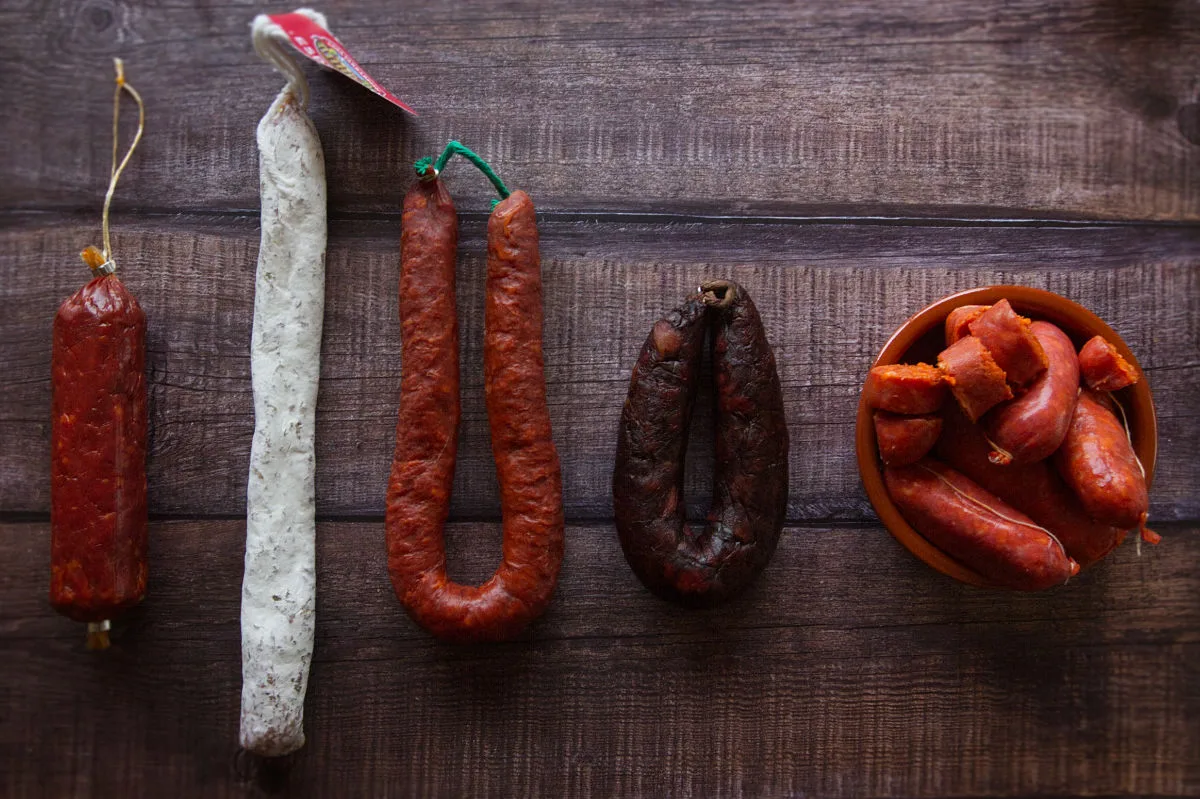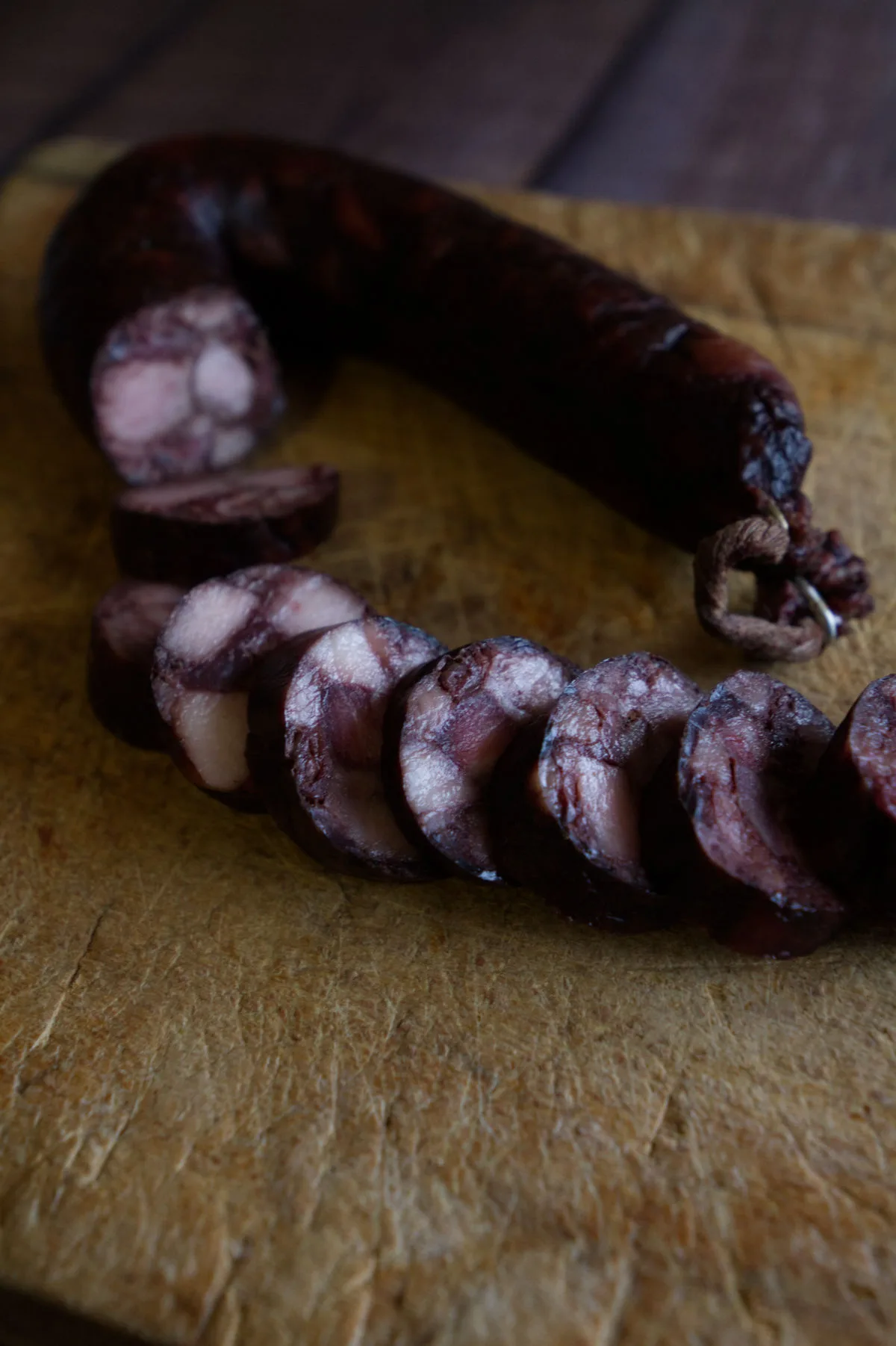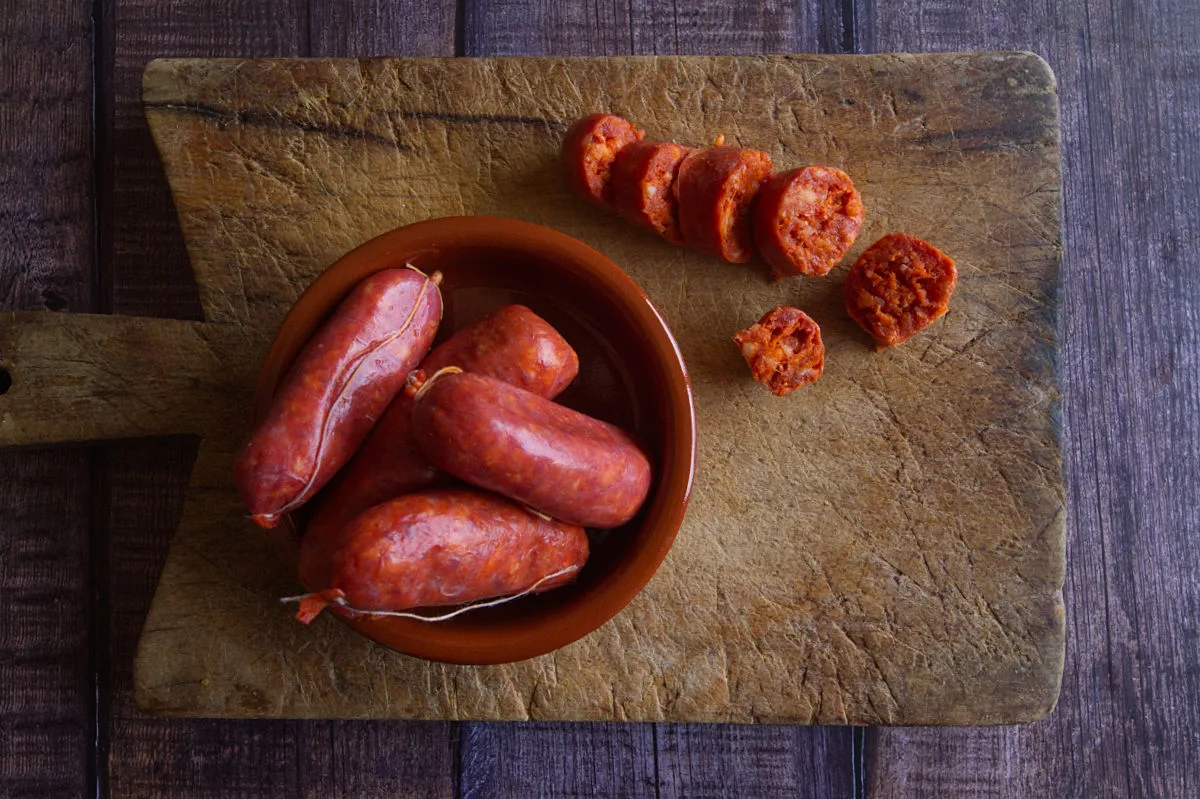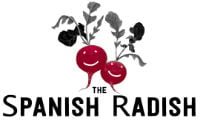Types of Spanish Chorizo
(Flavors, Recipes, and Traditions)

Discover Spanish Chorizo
Chorizo holds a special place in Spanish cuisine shaped by a strong cultural tradition that has been preserved throughout history. In this article, you’ll discover the different types of chorizo, their origins and history, and why each one is special.
We’ll also look into how chorizo is made, give you some great chorizo recipes, nutritional information, and where to purchase good quality Spanish chorizo in the US, Canada, UK, and Australia.
This post may contain affiliate links.
History of Spanish chorizo
The origin of the Spanish chorizo we know today dates back to the 16th century when paprika was introduced to Spain. It began to be used extensively to give chorizo meat its distinctive coloring and flavor.
The Spanish chorizo sausage was shaped historically by the many gastronomic traditions, festivals, and cultural and even religious traditions founded in many rural villages in Spain.
Unlike cattle that were bred outside of the villages, pigs were left to roam in denser urban environments and villages and were slaughtered by the families of the villages. This custom is referred to as “slaughter of the pig,” and still continues in some fashion today in small rural Spanish villages.
Chorizo is the first of the Spanish sausages defined by the Royal Academy of Language in the Dictionary of Authorities, 1726 as a “short piece of gut, filled with meat, regularly pork, chopped and seasoned, usually cured by the smoke.”
La Matanza
“La Matanza” refers to the traditional pig slaughter festivals that take place in different regions of Spain. Most of these festivals take place during the cooler winter months and these days the meat is typically delivered prepared on the day and there are stalls where various pork products, including chorizo, are made.
Often, the celebrations include a communal meal and the opportunity to learn about local pork products and how they’re traditionally prepared.

How Spanish chorizo is made
Spanish chorizo is made with minced pork meat, and pork fat that is generously seasoned with Spanish paprika and garlic, and stuffed into the natural pork intestine. Depending on the type of chorizo being made, other spices such as pepper, cumin, bay leaf, thyme, onion, and oregano may also be added.
The next step is to dry and cure the chorizo. The sausages are tied and exposed to air in the natural environment with good ventilation and specific temperature and humidity characteristics. A cool dry place is often best.
The chorizo is cured for around 50 days, with some types of chorizo sausage smoked using oak wood and then they are left to dry and cure.
For many villages and households in Spain, the making of chorizo is a cultural pastime that remains largely unchanged today.
Types of chorizo
There are many different varieties of chorizo found in Spain, although they can be divided into three distinctive types: cured, semi-cured, and soft (fresh) chorizo.
- Spanish soft chorizo (chorizo fresco)
This fresh, raw sausage is made from pork meat, pork fat, paprika, crushed red pepper, and garlic and must be cooked before eating.
- Semi-cured Spanish chorizo (semicurado)
This is a fresh sausage that has been fermented and in some cases, the meat is smoked, but not dried out completely. The fermentation process adds acidity and prolongs the shelf life of the chorizo.
- Cured Spanish chorizo (curado)
This type of chorizo is what is most commonly served as thinly sliced pieces, usually as tapas. The meat is cured, or fermented and dried until hard and has a long shelf life.
Types of chorizo by pork meat
- Chorizo Iberico Bellota: This type of chorizo is specifically made with Iberian pork ham or the Bellota Iberian ham.
- Chorizo Iberico: made with meat from Iberian pigs.
- Chorizo traditional: made with pork that is grown locally.

Spanish chorizo types by region
Chorizo de León
Perhaps one of the most famous regions for exporting chorizo is the town of León in the northwest of Spain. The chorizo is made with pork meat grown from the region and has the characteristic horseshoe-shaped sausage with both ends tied and usually dried on large poles in the open air. Chorizo from León is typically a dark red color and has a strong spicy flavor.
Galician Chorizo
Galician chorizo is made using lean pork, bacon, paprika, garlic, pepper, and salt. The curing process first smokes the sausages and later dries them in strings of sausages and stored in fat. Galician chorizo can be eaten raw, cooked, fried, or roasted.
Chorizo is an essential ingredient in many dishes in Galician cuisine such as fabadas (rich meat stews) and other recipes such as chestnuts with chorizo.
Chorizo de Pamplona
Originating from the Navarra region, Chorizo de Pamplona is known for its large size and slightly coarse texture. The sausage has a diameter of around 1.5-1.9 inches / 4-5cm and is seasoned with smoked paprika, garlic, salt, and sometimes wine or brandy. This chorizo is traditionally air-dried for several weeks, intensifying its flavors.
Chorizo de Pamplona consists of pork, beef, and sometimes bacon to a lesser extent. Once prepared and cured, the chorizo is eaten raw and offers a soft and creamy texture with a rich, intense flavor.
Chorizo Riojano
Hailing from the region of La Rioja, Chorizo Riojano is a mildly spicy sausage characterized by its vibrant red color and delicate smoky flavor. It is made using a mix of lean pork and pork fat, seasoned with paprika, garlic, salt, and other spices. Chorizo Riojano typically uses a spicy or smoked paprika, giving this chorizo sausage a distinctive spicy flavor.
Chorizo Extremadura
In Extremadura, chorizo patatera is a sausage that combines Iberian pork fat and mashed potatoes. The pattern is a horseshoe-shaped sausage and uses around 50% baked potato, 10% lean Iberian pork meat, and 40% fatty meat of the Iberian pig.
The sausage is a deep red color due to the use of La Vera paprika and gives the chorizo a sweet or spicy flavor depending on the paprika’s intensity. Patatera has a soft texture and is often smeared onto bread in a similar fashion to sobrasada.
Chorizo from Segovia
In Segovia, the chorizo best known is from the Segovian town of Cantimpalos and is celebrated each year at the end of April with the Cantimpalos Chorizo Fair (Feria del Chorizo).
The chorizo from this region is well documented and dates as far back as 1900. The sausage was exported as early as 1928 to Mexico and Southern America and Cantimpalos Chorizo received Protected Geographical Indication status in 2008 and is controlled by the Regulatory Council.
Cantimpalos Chorizo is made from pork (specifically animals fed with at least 75% cereals) and paprika, with at least 50% of the paprika sourced from La Vera (D.O.). Finally, the sausage is seasoned with salt. The sausage is then dried and cured for at least 21 days and can be presented as a string, or as individual sausages.

Chorizo from Cantabria
In Cantabria, one of the most popular forms of chorizo is from the small town of Potes. The ingredients used in Cantabrian chorizo produce are lean cuts of pork, bacon, salt, pepper, paprika, garlic, oregano, and thyme. The sausage can be consumed raw, dried, or cooked.
The sausage is hung to dry in the natural environment and wood-smoked using locally sourced oak for 25 days, giving it a distinctive and rich flavor. Chorizo from this region comes in a horseshoe shape and is tied with a continuous string of one unit to another.
Chorizo from Canarias
Chorizo and black pudding sausages are popular in the Canary Islands. Among the best-known is the Teror chorizo.
Chorizo Teror (chorizo de Teror) is a rich red-colored sausage that is made with paprika and the juiciest cuts of the pig. Chorizo de Teror’s ingredients include paprika, salt, white wine, spices, garlic, pork bacon, and lean meat.
The sausages are thick in diameter (around 1.5 inches / 4cm) and are easy to spread. It is characterized by the shiny skin and sausages will be tied together into a string. A white version is also made and its ingredients exclude paprika and instead use nutmeg.

Chorizo in recipes
Chorizo is a very popular ingredient in Spanish cuisine and can be found in numerous recipes. Chicken and chorizo is one such flavor combination that is sung high praises in many Spanish kitchens.
Of course, dried and semi-cured chorizo is perhaps best known served as a tapas or snack. Fresh chorizo is best used in recipes such as those below:
- Fabada Asturiana – Asturian bean stew (easy one-pot recipe)
- One-pot Spanish chicken and chorizo stew recipe
- Spanish chicken and chorizo pasta (super easy one pot)
- Smoky sweet potato chorizo recipe (Easy 30-min one pot)
- Spicy chicken and chorizo rice (filling, made in 1 hour)
- Easy Spanish chicken thighs with chorizo and wine
- Spanish chorizo cooked in cider
Spanish Chorizo Festivals and events
Chorizo is a popular ingredient in various Spanish festivals and cultural events. Here are some notable national festivals where chorizo and seasoned chorizo producers and exporters take center stage:
Covaleda Artisanal Chorizo Fair, Coveleda, Castile and León
The emblematic Covaleda Artisanal Chorizo Fair opens on the second weekend each March and brings together up to a hundred chorizo producers, who compete for the Best Chorizo in the World award.
Vila de Cruces (Feira Gastronómica do Chourizo) Food Fair Chorizo and Festival
The small Galician town of Vila de Cruces holds an annual gastronomic fiesta (Feira Gastronómica do Chourizo) and the chorizo (chourizo in Galician) is the star of the show. This festival, the biggest of its kind in Spain, attracts crowds of Chorizo fans from all over Spain and internationally.
Feria de la Chorizada, Extremadura
The Feria de la Chorizada takes place in various different towns and villages across the Extremadura region, which is renowned for its excellent chorizo production. These festivals are dedicated to showcasing the local chorizo culture and include activities such as chorizo tastings, cooking contests, cultural exhibitions, and live performances.
These festivals provide an opportunity for locals and visitors alike to experience the vibrant traditions, flavors, and craftsmanship associated with Spanish chorizo. They offer a deeper understanding of the cultural significance and regional variations of this beloved sausage.

Where to Buy Spanish Chorizo
United States
Spanish chorizo can be found in specialty gourmet stores, Spanish food markets, and online retailers such as La Tienda, La Española Meats, Spanish Pig, and Amazon. Additionally, some larger supermarket chains may carry imported Spanish chorizo in their international meat sections.
Buy Spanish Chorizo from Amazon
Canada
You can find Spanish chorizo in specialty gourmet stores and online retailers like Spanish Pig, Real Canadian Superstore, Amazon, and in Walmart.
United Kingdom
In the UK, Spanish chorizo is available in specialized Spanish food shops, delis, and some supermarkets. Online retailers like Brindisa, The Tapas Lunch Company, and Amazon UK also offer a wide selection of chorizo options.
Australia
Spanish chorizo is a little more expensive in Australia mainly due to strict border controls and import costs. Spanish chorizo can be purchased from gourmet food stores, Spanish specialty shops, and online platforms such as The Spanish Acquisition, The Essential Ingredient, and Harris Farm Markets.
Additionally, some larger supermarkets such as Coles and Woolworths with extensive international sections may stock Spanish chorizo.
Chorizo FAQs
Is Spanish chorizo raw or cooked?
There are three main types of Spanish chorizo, one raw and two that are cured and do not require cooking:
- Raw Chorizo (Chorizo fresco)
- Semi-cured Spanish chorizo (semicurado)
- Cured Spanish chorizo (curado)
Do you need to cook Spanish chorizo?
Raw chorizo that you find in the refrigerated section of any supermarket will require cooking before consumption. This is called Chorizo fresco in Spain. Other types of chorizo (cured and semi-cured chorizo) do not require cooking before consumption.
How long does chorizo take to make?
Most cured chorizo takes around 50 days to make. Chorizo fresco is raw and has not been dried or aged.
What is the white stuff on Spanish chorizo?
The white powdery substance that is found on the chorizo casing is mold. The mold is of penicillin species and is completely safe. Chorizo that has white mold on it is a good sign, as it indicates that the curing process has successfully eliminated any harmful bacteria.

which category does Basque Chorizo fit?
Hi, thanks for your question. Perhaps the most popular chorizo sausge from the Basque Country is the Chistorra sausage. It is long and slender and semi-cured, meaning it has been dried for a period and requires further cooking before consumption. It is common to find fried Chistorra in tapas, cooked and put into a traditional flatbread called ‘talo’, or steamed or boiled in other dishes. Chistorra is traditionally served in San Sebastián on 21st December each year on the feast day of Thomas the Apostle. Happy Cooking!